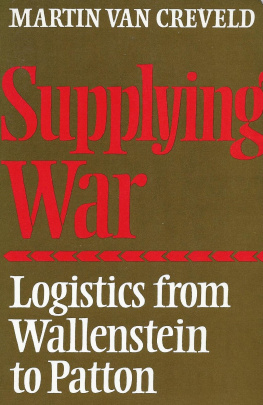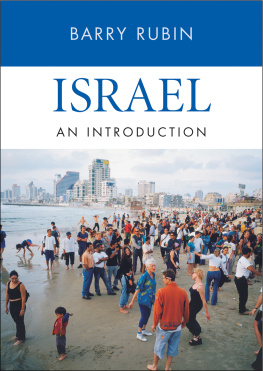The
LAND of
BLOOD and
HONEY
A LSO BY M ARTIN VAN C REVELD
Hitlers Strategy, 19401941: The Balkan Clue
Supplying War: Logistics from Wallenstein to Patton
Fighting Power: German and U.S. Army Performance, 19391945
Command in War
Technology and War: 2000 B.C. to the Present
The Training of Officers: From Professionalism to Irrelevance
The Transformation of War
Nuclear Proliferation and the Future of Conflict
Air Power and Maneuver Warfare
The Sword and the Olive: A Critical History of the Israel Defense Force
The Rise and Decline of the State
The Art of War: War and Military Thought
Men, Women, and War
The Privileged Sex
Moshe Dayan
Defending Israel: A Controversial Plan Toward Peace
The Changing Face of War: Lessons of Combat from the Marne to Iraq
The American Riddle
The Culture of War
The LAND
of BLOOD
and HONEY
THE RISE OF MODERN ISRAEL

Martin van Creveld
Thomas Dunne Books St. Martins Press  New York
New York
THOMAS DUNNE BOOKS .
An imprint of St. Martins Press.
THE LAND OF BLOOD AND HONEY . Copyright 2010 by Martin van Creveld. All rights reserved. Printed in the United States of America. For information, address St. Martins Press, 175 Fifth Avenue, New York, N.Y. 10010.
Maps copyright 2010 by Varda Weiss
www.thomasdunnebooks.com
www.stmartins.com
Text design: Meryl Sussman Levavi
Library of Congress Cataloging-in-Publication Data
Van Creveld, Martin, 1946
The land of blood and honey: the rise of modern Israel / Martin van Creveld.1st ed.
p. cm.
Includes bibliographical references and index.
ISBN 978-0-312-59678-1 (alk. paper)
1. IsraelHistory. 2. JewsIsraelHistory. I. Title.
DS126.5.V324 2010
956.9405dc22
2009047574
First Edition: August 2010
10 9 8 7 6 5 4 3 2 1
For Orr
To be a free people
in our own land,
the land of Zion
and Jerusalem
CONTENTS
PROLOGUE
Why and What For
Ever since the time when the idea of building a sovereign Jewish statethe first in almost two thousand yearswas floated during the last years of the nineteenth century, it has been surrounded by controversy. Consider, for example, the following passage by the well-known Jewish-Austrian writer Stefan Zweig (18811942):
I was still in the Gymnasium when this short pamphlet [Theodor Herzls Der Judenstaat (The Jewish State), 1896] was published... but I can still remember the general astonishment and annoyance of the middle class Jewish elements of Vienna. What has happened, they said angrily, to this otherwise intelligent, witty, and cultivated writer? What foolishness is this that he has thought up and written about? Why should we go to Palestine? Our language is German and not Hebrew, and beautiful Austria is our homeland. Are we not well off under our good Emperor Franz Josef? Do we not make an adequate living, and is our position not secure? Why does he, who speaks as a Jew and who wishes to help Judaism, place arguments in the hands of our worst enemies and attempts to separate us, when every day brings us more closely and intimately into the German world?
Since those faraway days, hardly a year has passed when doubts have not been cast both on the feasibility of the idea and on its desirability. Even today, countless people, especially but by no means exclusively in the Islamic world, continue to question Israels right to exist; more remarkably still, this even applies to some of the states own citizens. Some of them, from Iranian president Mahmoud Ahmadinejad to Hezbollah leader Hassan Nasrallah, engage in wishful thinking that they may, one day, do away with it.
This book will attempt to provide a brief but comprehensive outline of the rise of Israel, from its Zionist beginnings at the end of the nineteenth century to the present day. I want to explain its military, political, economic, social, and cultural development as well as the complicated ways in which these various pillars interact; also, to give readers who are neither Israelis nor experts a feel for what life is like in a country where almost everybody is a soldier on eleven months annual leave. Above all, in the face of the endless and often highly unfair criticism that is directed against Israel from all over the world, I want to show it for what it really is: namely, a country that, while coping with every imaginable obstacle, in many ways is perhaps the greatest success story in the entire twentieth century. It is also one whose progress in terms of maintaining and developing its democracy, economic growth, artistic creativity, academic excellence, and, last but not least, military might has eclipsed that of virtually all the rest, to the point where it is now able to field one of the most powerful armed forces on Earth.
The outline of the volume is as follows. , The Nightmare Years, deals with the difficult period from 1967 to 1980. In addition to two major wars (the 19691970 War of Attrition and the 1973 Yom Kippur War), this period saw the country confront formidable economic and social problems, leading to a real spiritual crisis but ending on a more optimistic note.
, Tragedy, Triumph, and Struggle, focuses on the vast cultural, social, and economic transformation that, starting in the mid-1980s, did much to turn Israel into a first-world country without, unfortunately, solving the problems between Arabs and Israelis or bringing about a situation where swords may finally be turned into plowshares.
Since the period covered here extends over almost a century, the amount of available source material was so vast that I could use only an extremely small part of it. Since my purpose was neither to shatter any myths nor to reveal any secrets, I decided to rely entirely on publicly available sources while dispensing with archival research. Most of the sources are in Hebrew and will mean nothing to foreign readers; hence, I have limited my references mainly to direct quotes. I hope I have succeeded in providing a reasonably coherent picture of where Israel came from; how it developed its unique character; and to what factors it owes its truly amazing, if not unblemished, success both on the battlefield and in other spheres. If so, then I will have achieved my purpose.
The
LAND of
BLOOD and
HONEY

FORGED IN FURY
(18971949)
A Terrible Land
During the nineteenth century, the land roughly known as Palestine was a remote and badly neglected province of the Ottoman Empire, of which it was a part of from 1517 on. Reflecting the undeveloped nature of the area, even its borders had not yet been properly defined. In 1917, the year when the London Geographical Journal published an article about its resources and suitability for colonization, the discussion included considerable parts of what today are Lebanon, Syria, and especially Jordan. The photographs that accompanied the text showed sites as far away as Baalbek and Amman.
The country known since Biblical times as , the Land of Israel (or simply the Land, as Jews and Israelis say), was considered part of Greater Syria, an arrangement that goes back to Hellenistic times. As if to deny it any political unity, it was divided into three districts. The northern one reached from Acre in the west to the Jordan River in the east and was governed from Beirut, which itself was ruled from Damascus. Farther south the district of Nablus was also governed from Beirut; however, it reached from the Mediterranean across the Jordan into the area known as Hauran, in southwestern Syria. Finally, Jerusalem was an autonomous province that came directly under Damascus.
Next page




















 New York
New York